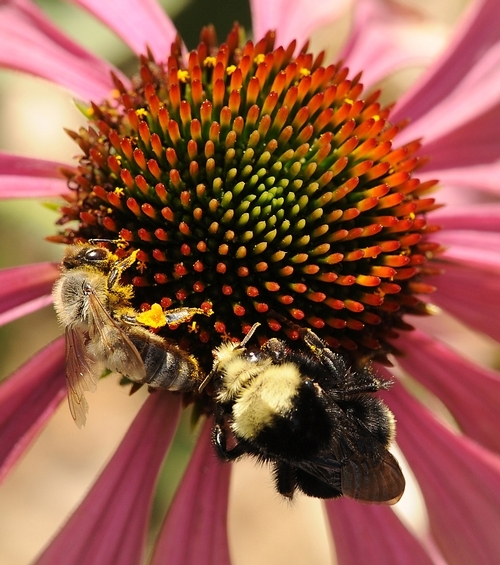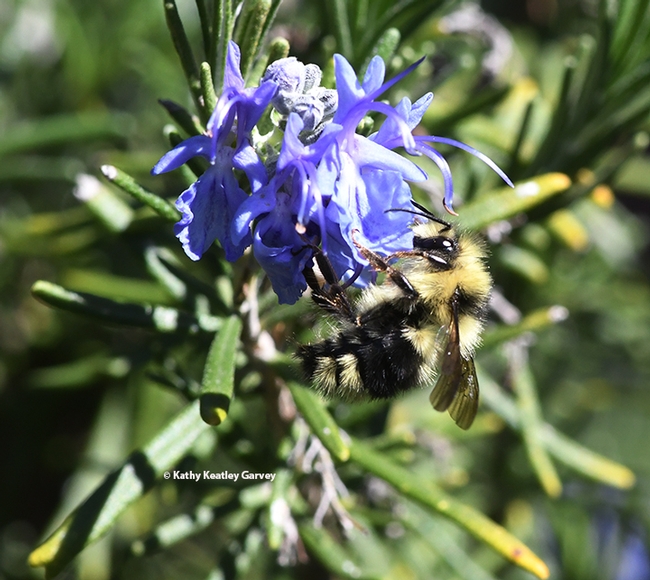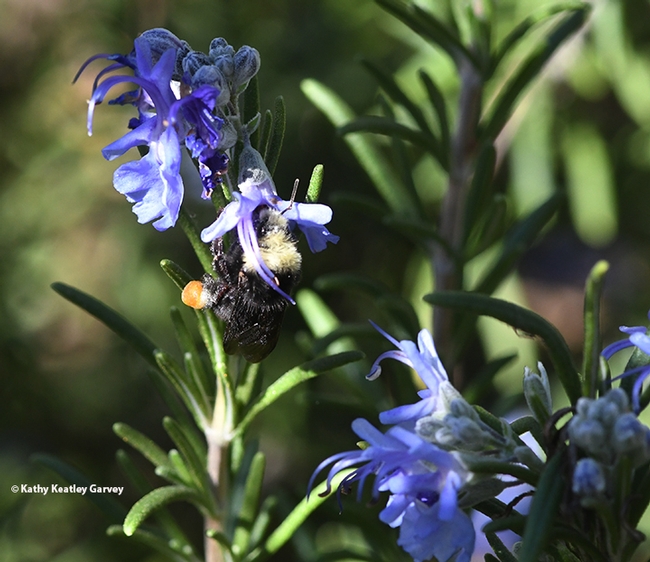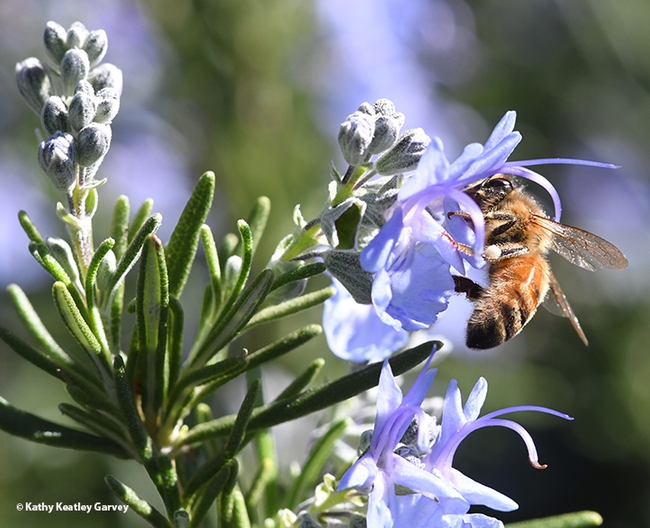
What does science tell us about this?
In a recently published EurekaAlert news story, titled "Research Reveals Why Plant Diversity Is So Important for Bee Diversity," researchers at the Laboratory of Apiculture and Social Insects at the University of Sussex, related that bumble bees have distinct advantages of honey bees.
"In the study, published in the journal Ecology, the researchers used stopwatches to determine how many flowers a bee visited in one minute," according to the news release. "Using a portable electronic balance to weigh each bee, researchers found that, on average, bumble bees are almost twice as heavy as the honey bees. This means that they use almost twice as much energy as honey bees. The stopwatch results showed that they visit flowers at twice the rate of honey bees, which compensate in terms of energy efficiency."
Bumble bees dominated on such species as lavender and "were visiting flowers at almost three times the rate of honey bees."
"While they forage on the same flowers, frequently we find that bumble bees will outnumber honey bees on a particular flower species, while the reverse will be true on other species growing nearby," said Professor Francis Ratnieks. "What was remarkable was that differences in foraging energy efficiency explained almost fully why bumble bees predominated on some flower species and honey bees on others."
The professor said that in essence, "bumble bees have an advantage over honey bees in being faster at visiting flowers, so can gather more nectar (energy), but a disadvantage in being larger, and so using more of the nectar energy to power their foraging. On some flower species this gave an overall advantage to bumble bees, but on others to honey bees."
(The late Robbin Thorp (1933-2019), distinguished emeritus professor at UC Davis and a global bumble bee expert, told us that bumble bees are earlier risers than honey bees and can forage at lower temperatures. He co-authored Bumble Bees of North America: An Identification Guide (Princeton University Press) and California Bees and Blooms: A Guide for Gardeners and Naturalists (Heyday Press).
The Sussex researchers studied 22 flower species in southern England and analyzed the behavior of more than 1000 bees. They found that "energy efficiency" is a key factor when it comes ot mediating competition.
"Bee bodyweight and the rate at which a bee visits flowers determine how energy efficient they are when foraging," according to the news article. "Bodyweight determines the energy used while flying and walking between flowers, with a bee that is twice as heavy using twice as much energy. The rate at which a bee visits flowers, the number of flowers per minute, determines how much nectar, and therefore energy, it collects. Together, the ratio of these factors determines bee foraging energy efficiency. On some flower species such as lavender, bumble bees dominated and were visiting flowers at almost three times the rate of honeybees."
The researchers said that energy (provided by nectar for bees) is a fundamental need, but the fact that honey bees and bumble bees do not compete head on for nectar is reassuring in terms of conservation and co-existence.
As Ratnieks explained: "Bumble bees have a foraging advantage on some plants, and predominate on them, while honey bees have an advantage on others and predominate on these. Bee conservation therefore benefits from flower diversity, so that should certainly be a focus on bee conservation efforts. But fortunately, flowering plants are diverse."
The abstract in Ecology:
"Revitalizing our understanding of species distributions and assembly in community ecology requires greater use of functional (physiological) approaches based on quantifiable factors such as energetics. Here, we explore niche partitioning between bumble and honey bees by comparing a measure of within-patch foraging efficiency, the ratio of flower visitation rate (proportional to energy gain) to body mass (energy cost). This explained a remarkable 74% of the variation in the proportions of bumble to honey bees across 22 plant species and was confirmed using detailed energy calculations. Bumble bees visited flowers at a greater rate (realizing greater energy benefits) than honey bees, but were heavier (incurring greater energy costs) and predominated only on plant species where their benefit?:?cost ratio was higher than for honey bees. Importantly, the competition between honey bees and bumble bees had no consistent winner, thus highlighting the importance of plant diversity to the coexistence of competing bees. By contrast, tongue?:?corolla-tube-length ratio explained only 7% of the variation (non-significant). Our results confirm the importance of energetics in understanding community ecology and bee foraging niche and highlight the energetic tightrope navigated by foraging bees, since approximately half the nectar energy gained was expended in its collection."
Attached Images:

A black-tailed bumble bee, Bombus melanopygus, foraging on rosemary at the Benicia Capitol State Historic Park on Feb. 23, 2021. (Photo by Kathy Keatley Garvey)

A yellow-faced bumble bee, Bombus vosnesenskii, foraging on rosemary at Glen Cove Marina, Vallejo. (Photo by Kathy Keatley Garvey)

A honey bee, Apis mellifera, foraging on rosemary at the Benicia Capitol State Historic Park on Feb. 23, 2021. (Photo by Kathy Keatley Garvey)